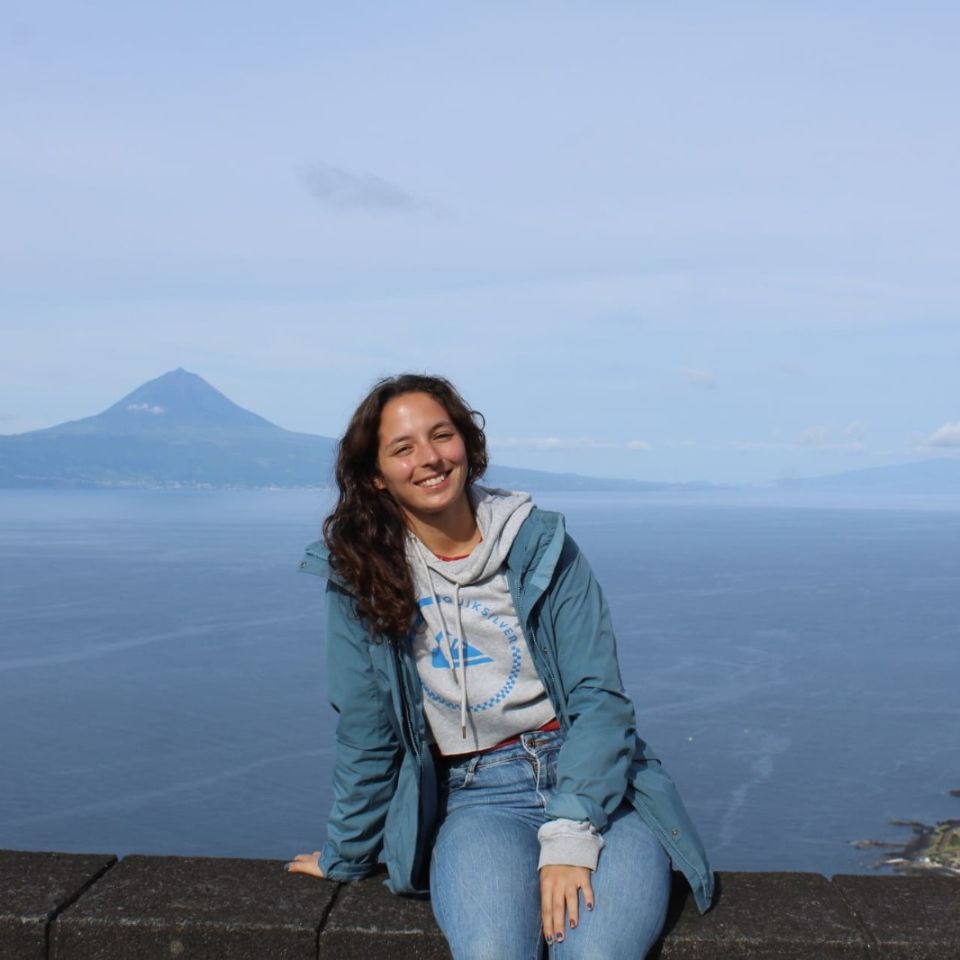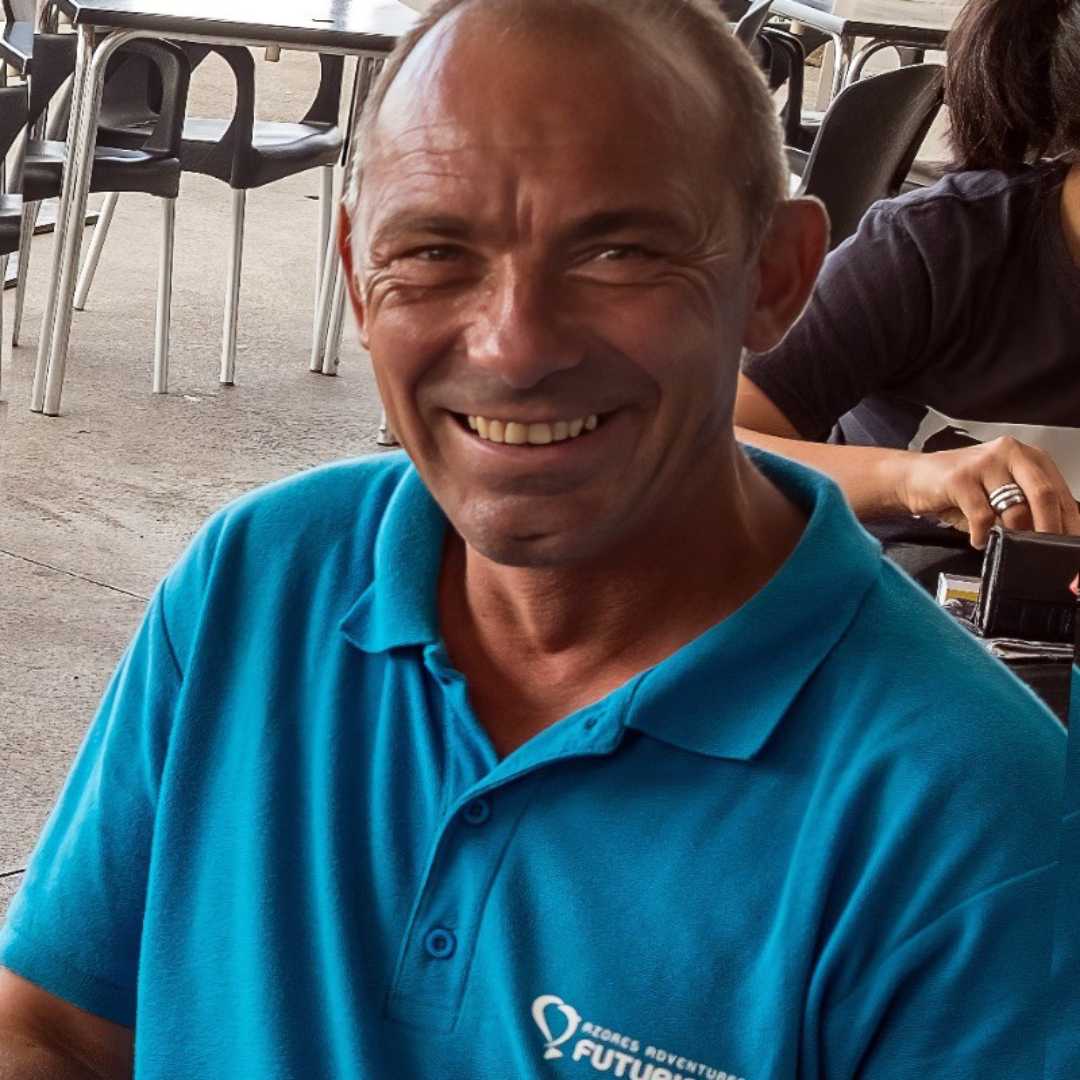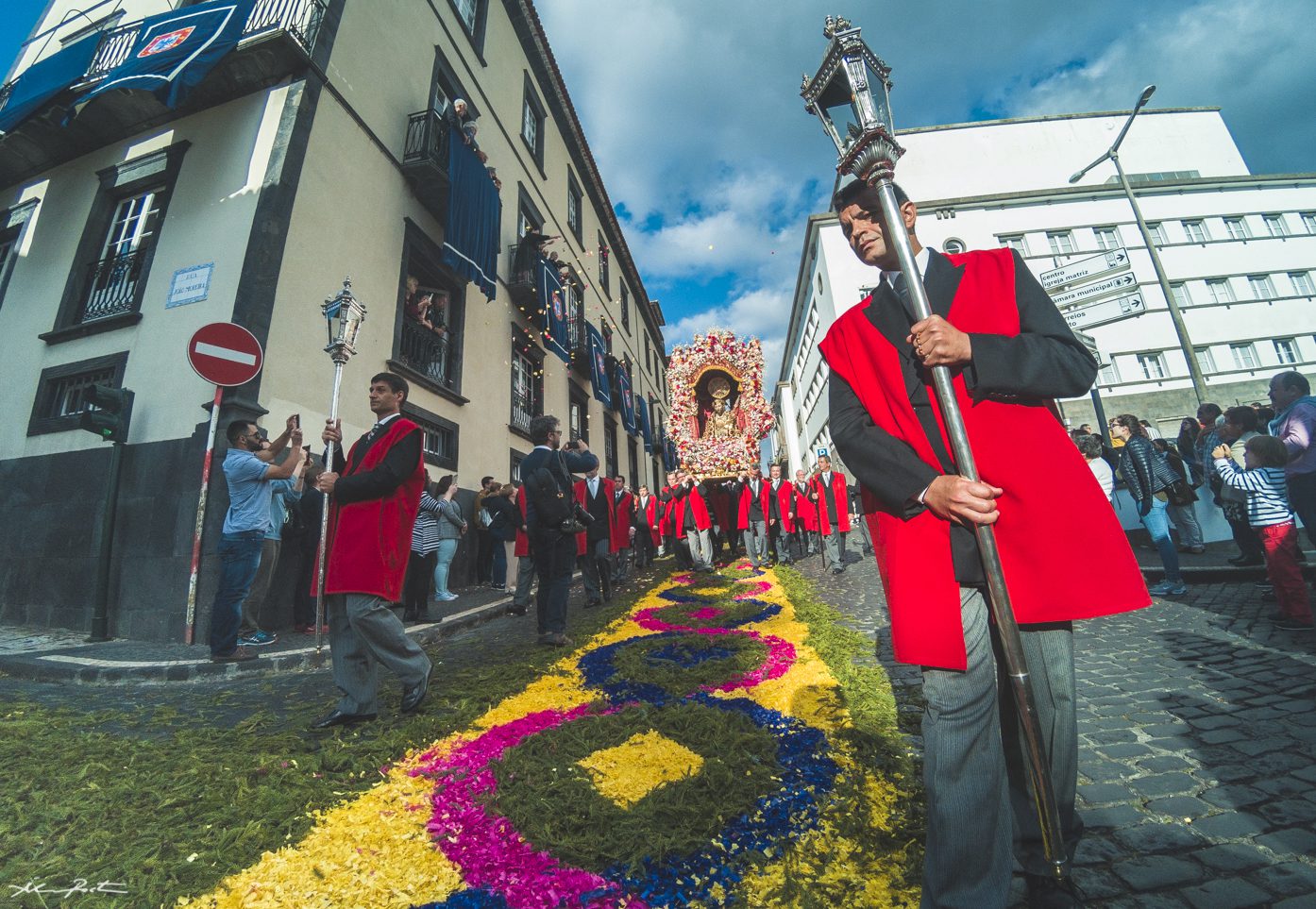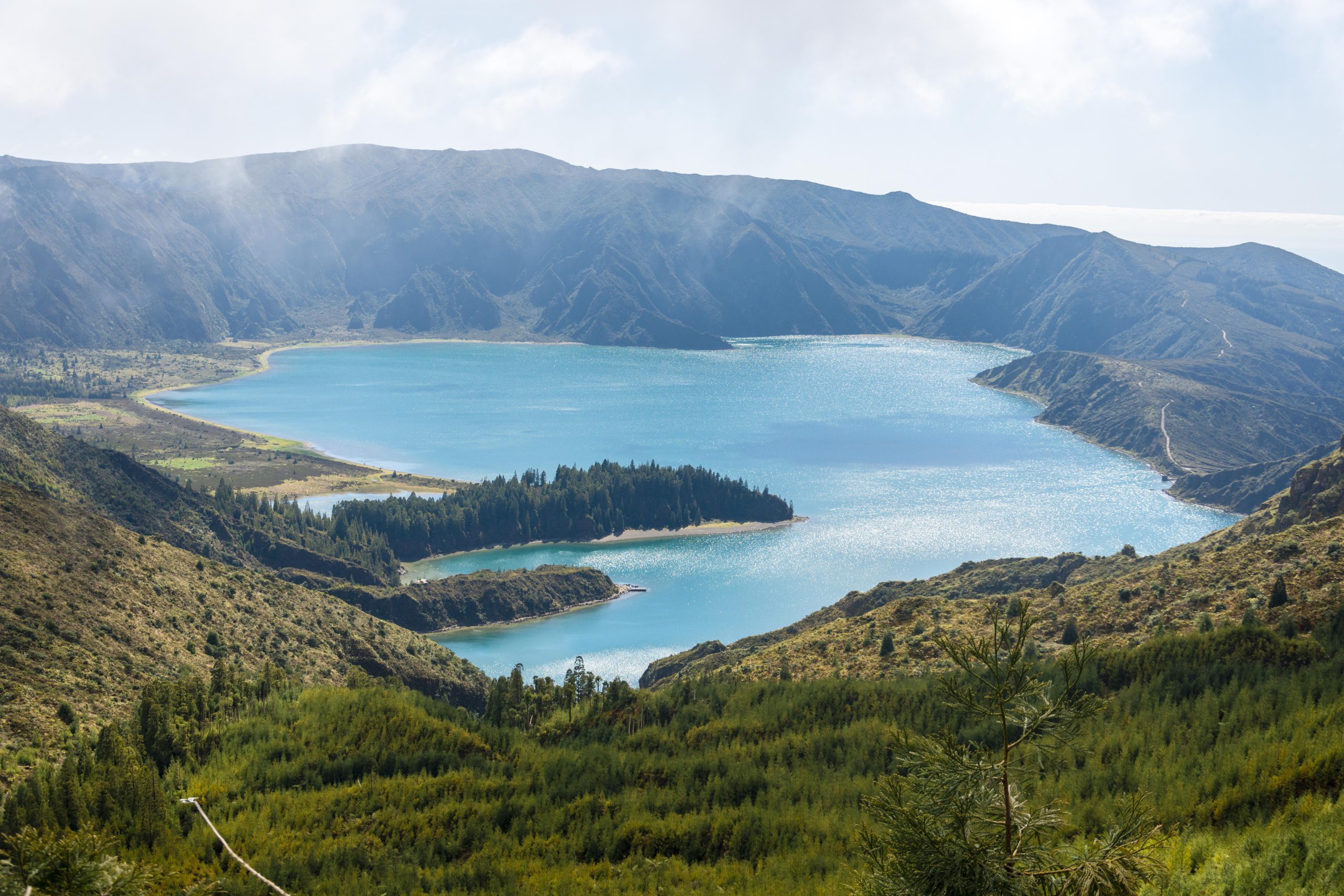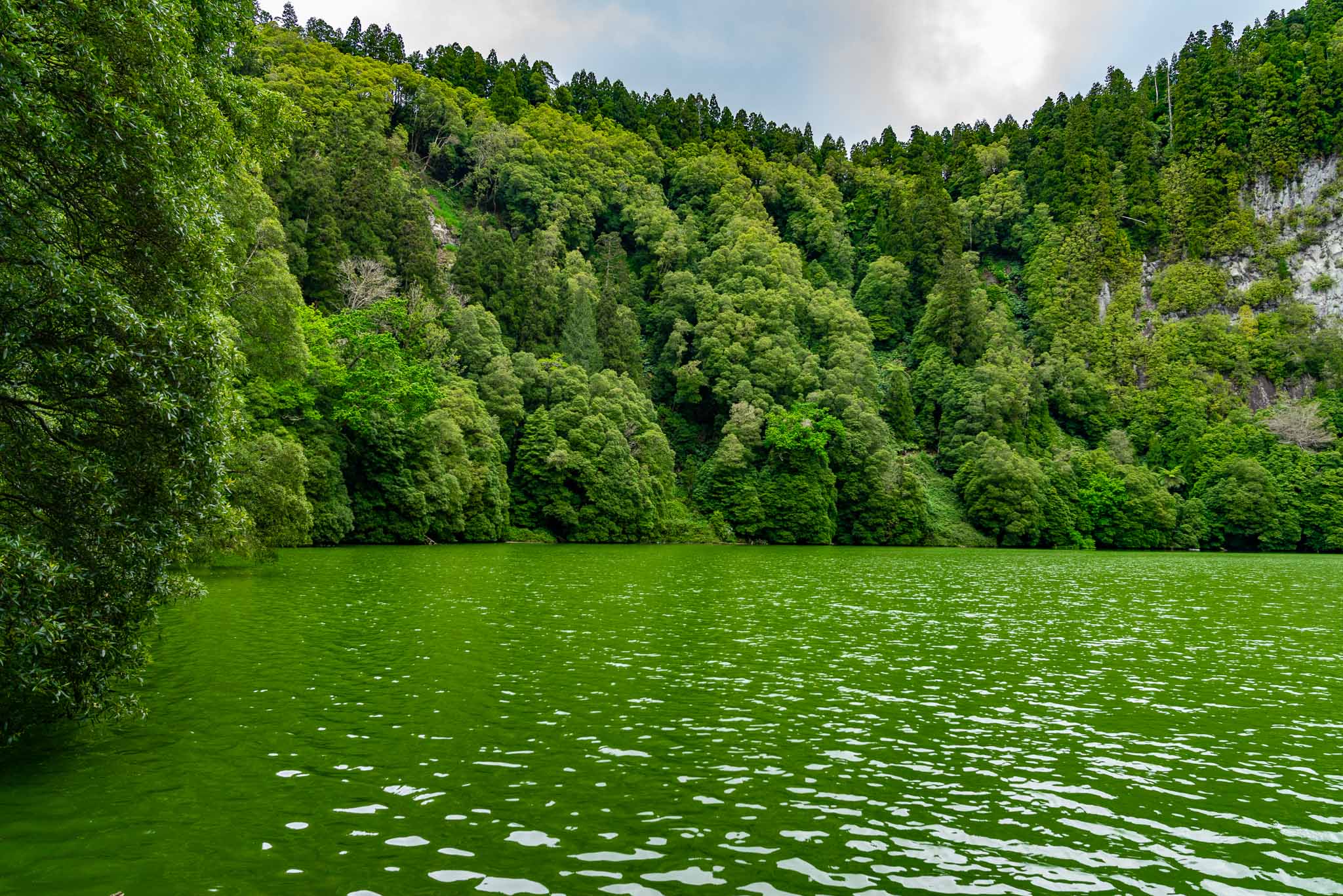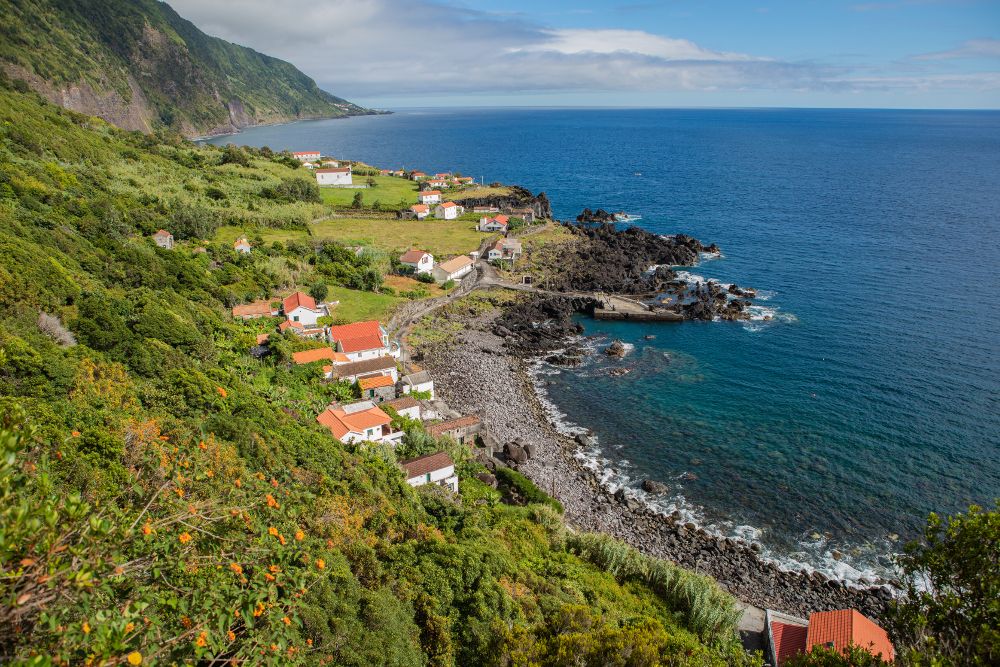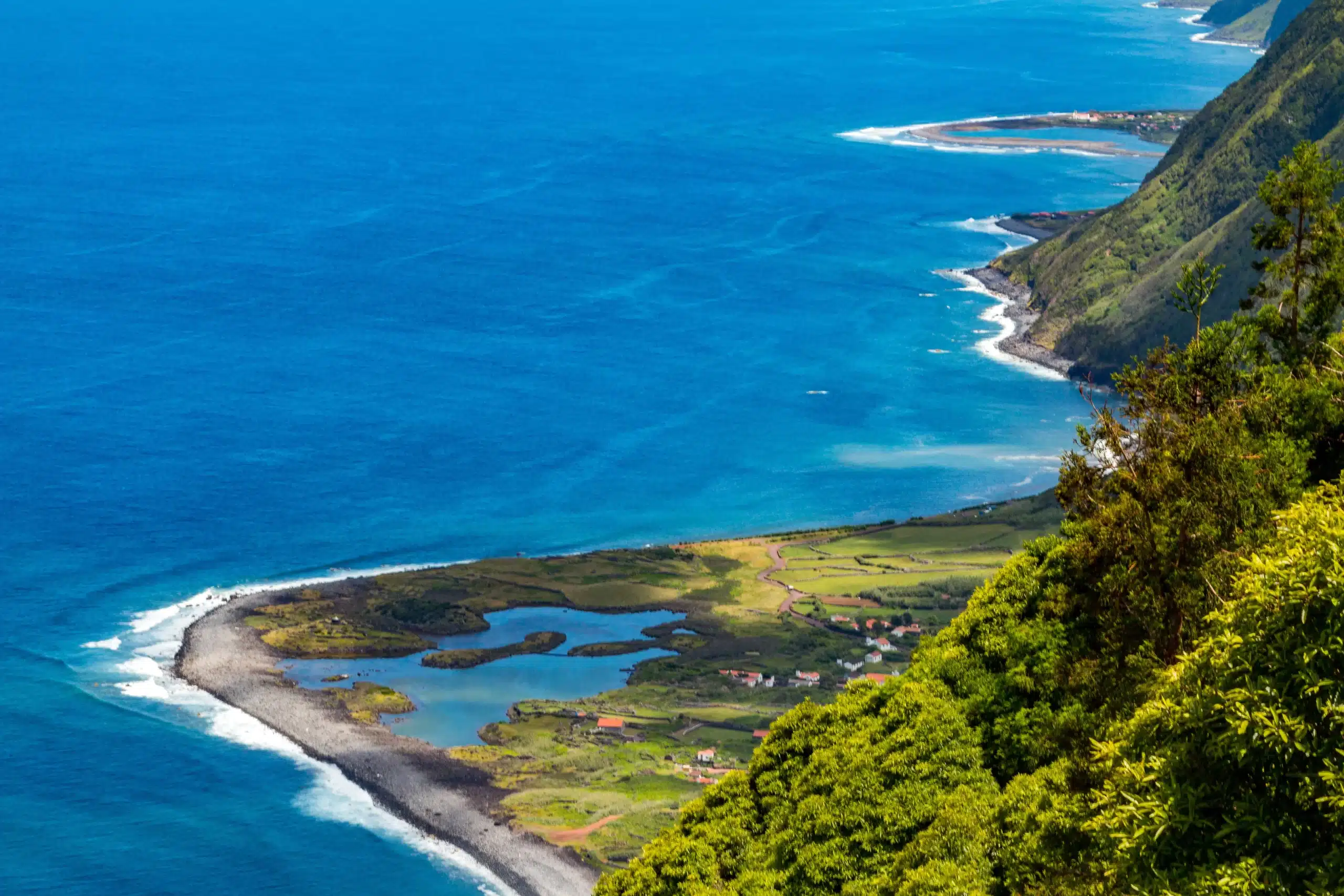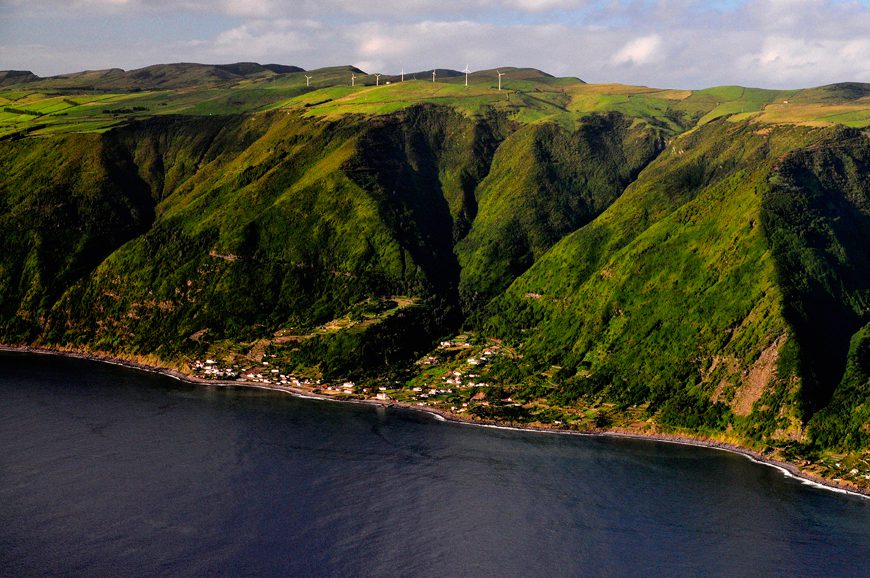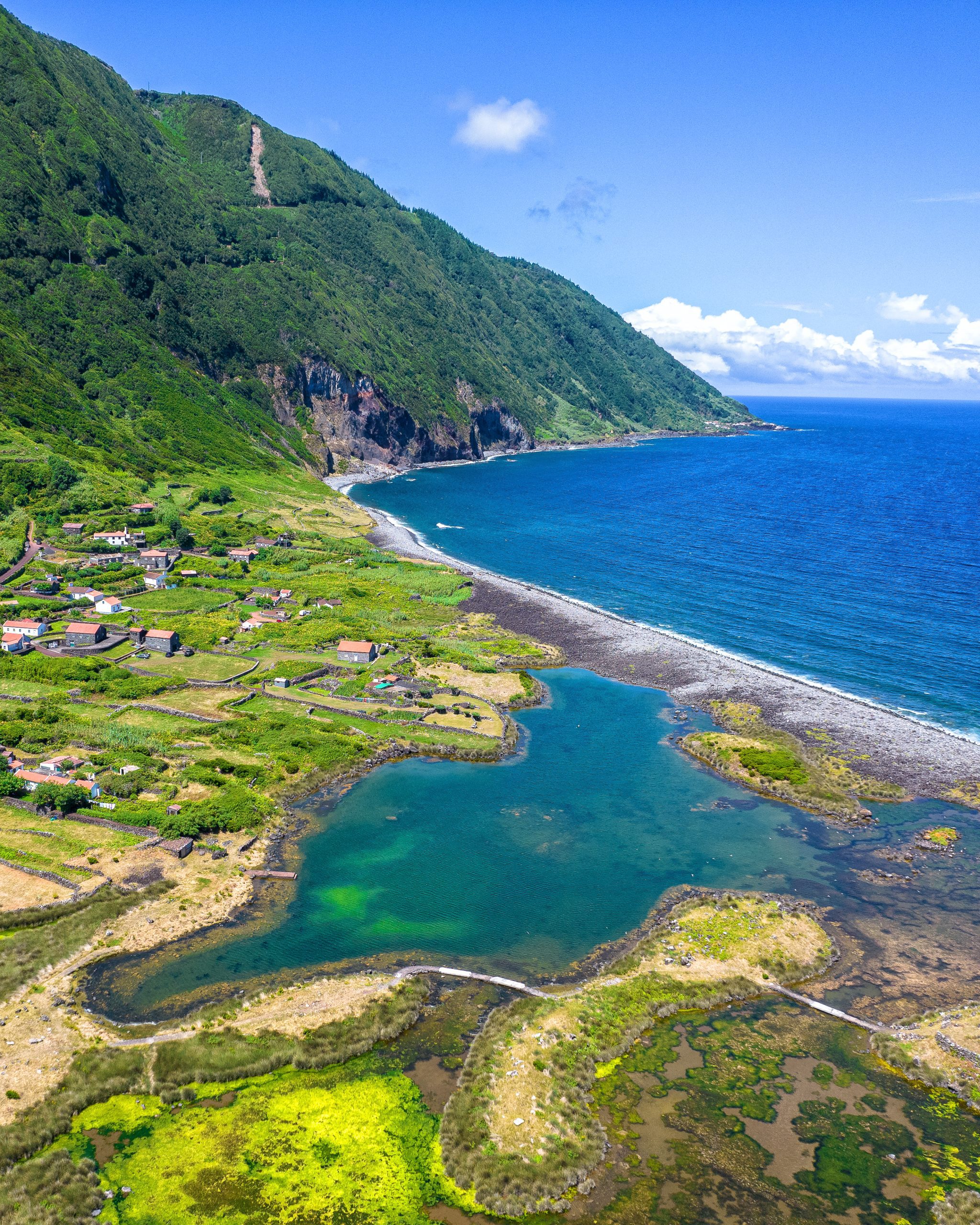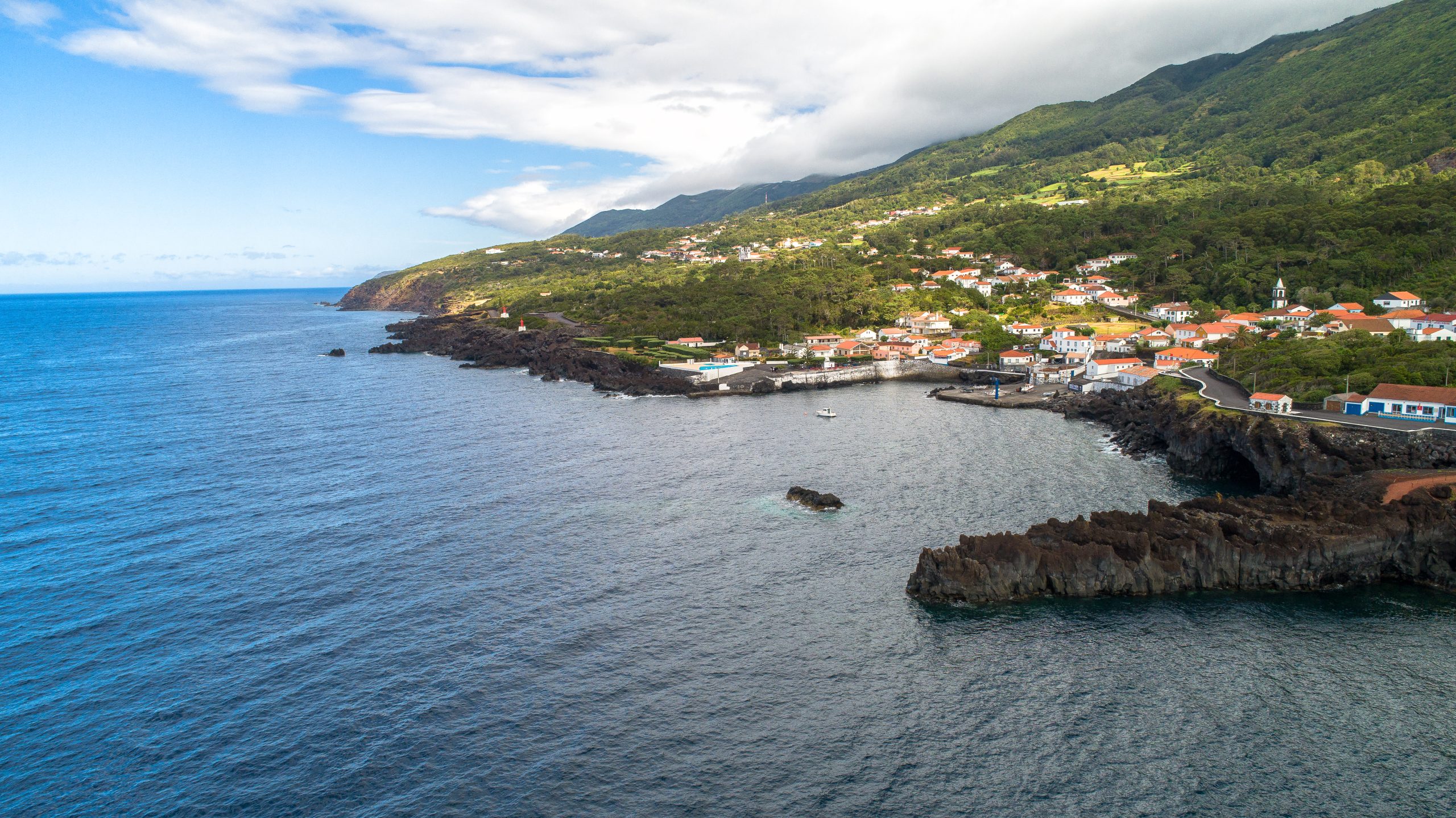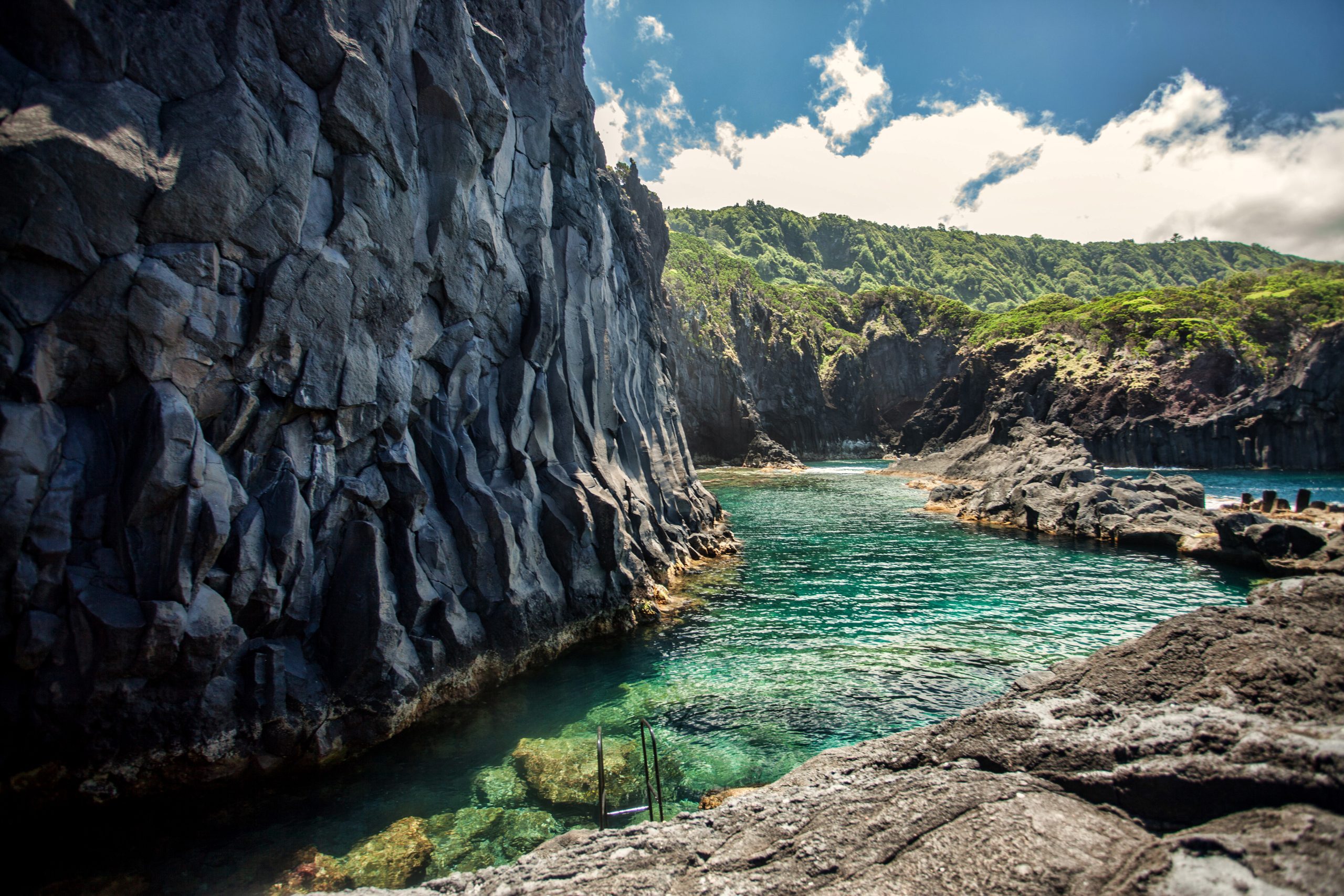Fajã dos Cubres is a popular destination on the northern coast of São Jorge Island in the Azores archipelago. It is a small village situated on a flat area of land by the ocean — known as a Fajã — surrounded by cliffs, and it is renowned for its stunning natural beauty.
This village has been drawing visitors from around the world for its stunning natural beauty and serene atmosphere. It is indeed one of the most amazing landscapes of the ‘Dragon Island’ and was even awarded one of the 7 Wonders of Portugal in the Seaside Villages category.
In this article, we will cover all you need to know about this magical place deeply connected to nature, including its history, animal and human inhabitants, and what to do in this little Atlantic paradise.

What is Fajã dos Cubres
Geology & Volcanology

One of the main attractions of Fajã dos Cubres is its stunning natural beauty. The village is surrounded by cliffs that plunge into the Atlantic Ocean. The cliffs are covered in lush green vegetation, making them a haven for birds. Inside Fajã dos Cubres, you can also find a coastal lagoon filled with seawater right by the ocean, home to a diversity of wildlife.
One of the unique features of this fajã is its geological formations. The village itself is situated on a fajã, a flat lava delta formed by volcanic eruptions and landslides. This creates a truly unique natural setting, a town between high green cliffs and the ocean. São Jorge is known as the island of Fajãs because it features over 70 of them.
History & Geography

São Jorge Island, like the other islands of the archipelago, was discovered in the 15th century, following the discovery of the eastern islands of São Miguel and Santa Maria. Fajã dos Cubres was not an accessible place, so the village was first used as a grazing area for cattle. You could only access it by boat or by walking a long, downhill trail.
Did you know
Unfortunately, the little village of Fajã dos Cubres was destroyed by the earthquake of July 9, 1757, and then by another big one in 1980.
So, the locals rebuilt their town twice but never gave up! There was once a school; however, due to a lack of students, it closed. Currently, approximately 50 people reside in the Fajã.
Fauna & Flora

Fajã dos Cubres is a real sanctuary for an incredible biodiversity of wildlife. Indeed, this place was classified as a Wetland of International Importance by the Ramsar Convention back in 1971. Although fishing has always been an integral part of the locals’ lifestyle, it is done with consideration for this beautiful natural gem. Fishermen from all over the island go to the lake in the village to catch shrimps that will serve as a lure for fishing groupers. Among the fish you can see at Fajã dos Cubres are the mullet, parrotfish, and wrasse.
Aside from the many cows living outdoors grazing all around town — valued for their tasty cheese, which is a symbol of the island — you can spot many birds and marine life when you look closely.
Regarding the vegetation, let’s begin with the name ‘Cubres’, which is Goldenrods (Solidago sempervirens), a plant with small yellow flowers that is abundant in the village. Then, you can find many reeds around the lake. Finally, the soil is very fertile, so you will mostly see cultures of corn, vines, and potatoes.
Culture & Festivities

The natural disasters at Fajã dos Cubres have instilled more faith in the people, and every year, a large religious event takes place in the village: Nossa Senhora de Lourdes. Every second Sunday of September, there is a mass, procession, and auctions of the offerings of the faithful.
The village hermitage was blessed in 1908. It houses a beautiful image of Senhor dos Passos. At low tide, behind the little church, you will find a well. Locals believe that the miraculous water cures diseases.
What to Do at Fajã dos Cubres

Many visitors come here to enjoy the peaceful atmosphere and admire the scenery, which includes views of the nearby islands of Terceira and Graciosa, as well as the Atlantic Ocean. Some popular activities in the area include hiking, surfing, paddling, and quad biking.
Visit the Tiny Village

Dotted with traditional stone houses, Fajã dos Cubres is a perfect example of a typical fajã and is so photogenic. Take a stroll in the narrow streets of this fantastic place located in such an unlikely place. Don’t forget to visit the century-old church.
The houses fit perfectly in the landscapes. You will not find any buildings that are higher than two floors or supermarkets. The high cliffs perfectly protect the village while also opening it up to the ocean. It is a very peculiar way of life. To protect the inhabitants from the sea, you will see the natural protection all around: black pebbles. Everything about Fajã dos Cubres makes it a special place.
Taste the Clams

Fajã dos Cubres has a couple of small restaurants that serve traditional Azorean dishes. Among them, you should not miss the giant clams of Caldeira de Santo Cristo, the neighboring fajã. The introduction of this species in this remote area of the world is still a mystery, but you can find them in all the menus. They are larger and more flavorful than regular clams, although they are typically served with garlic, onion, and olive oil. Locals use bread to taste the delicious sauce.
The typical meals also include various kinds of fish caught directly off the island’s coast. The meat you will find is from cows that graze outside all year long in our Azorean pastures. For the sweet tooth, don’t forget to have an ‘espécie’, the traditional pastry from the Dragon Island.
Wander Around the Lake

The big saltwater lagoon in Fajã dos Cubres has a peculiar shape. Thanks to a path created by men connecting several islets, you can walk inside. Those are paradises for birds nesting inside, making it a good spot to bird-watch migratory seabird species.
Take a Quad Bike Ride to Fajã da Caldeira de Santo Cristo

Fajã da Caldeira de Santo Cristo is only 3 kilometers away from its nearby sister, Fajã dos Cubres. It is accessible exclusively via Fajã dos Cubres, either via a dirt road or a long, downhill trail from Serra do Topo. This remoteness makes the fajã a heavenly place, perfect for relaxing in the midst of fantastic nature.
Quick Info
No cars can pass on the dirt road. There is a parking lot at Fajã dos Cubres, and from there, you can only go by foot or by quad!
Ask locals about taking you there in their fierce 4×4 quads for a few euros; you won’t regret the ride.
Plan Your Visit to Fajã dos Cubres

Best Season to Visit São Jorge Island
The best time to visit São Jorge Island, Azores, is during the spring months (April to June) and summer months (July to September). During this period, the climate is milder, and the temperatures are more pleasant for exploring the region and enjoying the natural landscapes.
In addition, the flora will be lush, and many outdoor activities, such as hiking, boat trips, and visits to vineyards and orchards, are possible. It’s important to note that the climate in the Azores can be unstable throughout the year, so be prepared for weather variations, even during the warmer seasons.
Check all our articles about the weather in the Azores throughout the year 🌤️ ☔️: January | February | March | April | May | June | July | August | September | October | November | December
Best Time of the Day to Visit
There is no particular best time of day to visit Fajã dos Cubres, but if you are not planning on staying the night there, we recommend going early in the morning to have time to explore this incredible region of the island. From there, you can watch a beautiful sunrise over the Atlantic Ocean, so that’s another reason to go and start your day early. You will have plenty of things to do and sights to see.
How to Get to Fajã dos Cubres
To reach Fajã dos Cubres, visitors must first fly to São Jorge Island. There are regular flights from Lisbon and Porto to several islands of the Azores archipelago. Then you can reach São Jorge by ferry from the nearby islands of the central group, like Faial, Pico, Terceira, and Graciosa. From São Miguel, there are currently no ferries, but you can catch a small propeller plane with Azores Airlines.
Once on São Jorge Island, visitors can reach the fajã by car or taxi. The village is located approximately 30 km from the island’s main town, Velas. For those who prefer to walk, many hiking trails lead there. The city is in the parish of Ribeira Seca, Calheta County. They only carved the road towards the fajã in the rocks and put concrete in 1993.
What to Bring

For a day full of adventures, make sure to bring comfortable shoes. If you intend to hike to Fajã da Caldeira de Santo Cristo first and then Fajã dos Cubres via Serra do Topo, we recommend good hiking boots. A rain jacket is always a good item to have with you, as the weather can change quickly.
It is possible to rent a stand-up paddleboard at Fajã da Caldeira de Santo Cristo. But in Fajã dos Cubres, it is not common to see people swimming. Moreover, be sure to take some water, as you will find a couple of vendors selling it around the village.
Where to Eat
If you need somewhere to eat near Fajã dos Cubres, click here. In this link, you’ll find the 10 best restaurants on TripAdvisor.
Where to Stay
To make your life easier, we’ve filtered the search by:
Pro Tips

If you intend to visit Fajã dos Cubres, you should also include Fajã da Caldeira de Santo Cristo. It would be a pity to do one and not the other. Both are exceptional and have unique features. Spend a night down in the village that only had electricity a few years ago for a once-in-a-lifetime experience.
The final tip is to explore the area thoroughly. Visit the lagoon and its surroundings, explore the church, and engage with the locals. This is such a wonderful place with friendly people. You will learn a great deal about life on the fajã.
What to Do Around Fajã dos Cubres
Go to the Viewpoint of Fajã dos Cubres

Up the hill before arriving at Fajã dos Cubres by the concrete road, you will find Miradouro da Fajã dos Cubres. This is a famous viewpoint from where you can admire the beauty of both Fajã dos Cubres and Fajã da Caldeira de Santo Cristo, and truly see what a fajã is, physically speaking.
Surf at Fajã da Caldeira de Santo Cristo

It is a magical place! This nature reserve is considered a sanctuary for surf and bodyboard lovers. In this fajã, you can also go hiking or kayaking in the lagoon. In addition to the pure nature experience, the Fajã offers excellent cuisine.
Swim at Poça do Simão Dias Natural Pools

Otherworldly is what better describes Poça do Simão Dias. It is undoubtedly one of the most beautiful natural pools you will ever see. The contrast between the vast, dark basalt stone walls and the blue water creates a peculiar atmosphere unique to that place. Please remember to bring a mask and snorkel to explore the unique underwater landscapes of this natural gem. Moreover, note that lifeguards do not watch this pool.
Explore Pico da Esperança

The highest point of the island is the best place for stunning views. From up there, observe the “dormant dragon” and the other four islands around. On a cloudless day, it is quite a fantastic panorama.
→ Check all our articles about each one of the most relevant points of interest on São Jorge Island: Fajã das Almas | Fajã do Ouvidor | Fajã de Santo Cristo | Fajã dos Vimes | Urzelina
Complementary Information
Best Season to Visit the Azores
The Azores Archipelago boasts a unique climate that shapes its lush landscapes, making it a splendid year-round destination. With mild temperatures and minimal fluctuations, each season offers something unique. Spring averages 16 °C, summer reaches 21 °C, autumn cools to 18 °C, and winter remains mild at 14 °C.
→ For a detailed breakdown of the weather by month, check the following links 🌤️☔️: January | February | March | April | May | June | July | August | September | October | November | December
How to Get to the Azores
The Azorean Archipelago is easily accessible through numerous flight routes. Lisbon and Porto are the main entry points to the continent, with direct flights available to São Miguel (PDL), Terceira (TER), Faial (HOR), Pico (PIX), and Santa Maria (SMA). To find the best flight, use search engines like eDreams or Skyscanner. These platforms let you compare prices and schedules from multiple airlines in one convenient location.
For more details on how to get to the Azores, take a look at our complete guide. But what if you want to explore beyond your arrival island? We’ve got you covered!
- Azores airports 🛬
- Flights between islands ✈️
- Ferries between islands ⛴️
- Which island to choose? 🏝️
- What airlines fly to the Azores? 🛩️
→ Once you’ve found the perfect route, book your tickets and get ready to experience one of the world’s most stunning island groups!
Travel Essentials
Essential Information for your Azores trip: Azorean Language & Phrases 🗣️ | Currency & Banks 💵 | Credit Cards & Traveler’s Cheques 🏧 | Driving in the Azores 🚗 | Electricity 🔌 | Experiences & Tours 🗺️ | Health & Safety 🩺 | Internet & Wi-Fi Access 🛜 | Phones & Mobile Service 📞 | Post Offices & Buying Stamps ✉️ | Public Holidays 🏖️ | Shopping 🛒 | Time & Daylight 🕒 | Whale Watching Guide 🐳 | Best Island to Visit 🏞️
Useful Tools & Apps
The weather in the Azores can be variable, so it’s helpful to use some apps before visiting the islands. Spotazores provides live camera feeds from the main tourist attractions, allowing you to check the weather and plan your visit. For accurate weather predictions, use Windy or Windguru — they provide the most reliable predictions.
Video
Conclusion
Fajã dos Cubres is such a breathtaking place. It is unique in this world. Whereas all fajãs of São Jorge are beautiful, this one deserves a highlight and a spot on your must-visit list in the Azores. In addition to delicious gastronomy and a welcoming local population, this atypical village displays an out-of-this-world beauty. It is the perfect destination for those who want to see some Azorean culture and a sample of our pure nature. Fajã dos Cubres will immerse all its visitors in the Azorean world, offering an experience that awakens all the senses.
Authors’ Note
I am pleased to inform you that all the recommendations in this article are based on my personal experience and observations. As the author, I have personally visited each attraction mentioned, ensuring that every suggestion is grounded in first-hand knowledge and genuine enthusiasm.
FAQs
Fajã dos Cubres is situated in the parish of Ribeira Seca, within the municipality of Calheta, on the island of São Jorge in the Azores.
The best time to visit is between May and September, when the weather is sunnier, making it ideal for hiking and enjoying the views.
At Fajã dos Cubres, you can explore the village, walk around the lagoon, taste local clams, and take ATV tours to Fajã da Caldeira de Santo Cristo.
Due to the uneven terrain and limited infrastructure, access may be challenging for people with reduced mobility.

